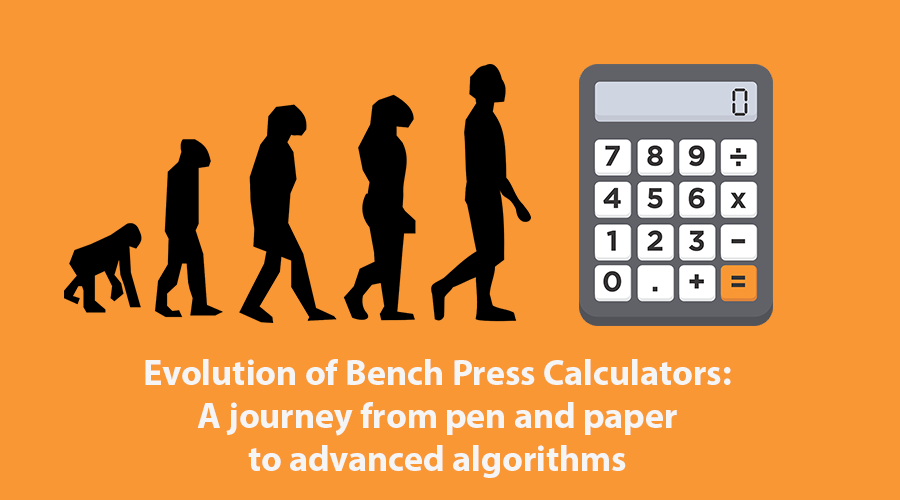
The bench press is a cornerstone exercise in strength training, revered by athletes, bodybuilders, and fitness enthusiasts alike. As with any exercise, the pursuit of progress is eternal; always aiming for that next weight milestone or perfecting technique. This is where the bench press calculator comes into play. From its rudimentary beginnings with pen and paper to the complex algorithms of today, this tool has traveled a transformative journey. This article charts the course of this evolution, exploring the intricate relationship between technology and physical achievement.
The Beginnings: Pen, Paper, and Observation
In the earliest days of strength training, there were no calculators for athletes. Training techniques and strength gauging were based largely on observation and anecdotal experiences. Coaches and athletes would estimate one's maximum lifting capacity based on previous lifts, adding incremental weights in subsequent sessions to test limits.
This method, while effective for its time, was largely trial and error. There was no standardized way to predict or calculate potential, and this occasionally led to plateaus in progress or even injury. Nevertheless, these rudimentary methods laid the foundation for the need for more advanced and predictive tools.
The Rise of Formulas and Basic Calculations
As the science of sports physiology developed, so did an understanding of muscular capability and performance prediction. In the 20th century, several researchers proposed formulas to estimate the one-repetition maximum (1RM) based on the number of repetitions one could perform at a given weight. These formulas provided a more systematic approach to predict 1RM, eliminating some guesswork.
While these formulas provided a valuable tool, they still required manual calculation. Athletes or coaches would write down the weight lifted and the number of repetitions, then plug these into the formula to get an estimate of 1RM. This method was revolutionary for its time, offering a more scientific approach to strength training.
Digital Age: The Birth of Software and Apps
With the rise of personal computers and smartphones, there came a significant shift in how bench press calculators functioned. No longer constrained to manual calculations, developers started creating software and apps to automatically compute one's 1RM based on provided inputs.
This digital transformation allowed for more variables to be included in calculations, such as age, gender, training experience, and even fatigue levels. Additionally, with the convenience of apps, athletes could track their progress over time, seeing clear visual representations of their strength trajectory.
Machine Learning and Advanced Algorithms
In recent years, the integration of machine learning and artificial intelligence has taken bench press calculators to new heights. These systems learn from vast amounts of data, tailoring their predictions to individual users with unprecedented accuracy.
By analyzing patterns in an athlete's performance, combined with data from thousands of other users, these advanced algorithms can provide insights not only on one's current strength but also on optimal training strategies, recovery periods, and potential risk of injury. They offer a holistic view of an athlete's journey, providing both the 'where you are' and hints of 'where you could go'.
The Personal Touch: Customized Training Programs
With the sophistication of bench press calculators, the most recent development is the integration of personalization into strength training regimens. Beyond just providing a number or a prediction, modern algorithms are now capable of tailoring specific training recommendations to an individual.
Take for example the app-based calculators that not only display one’s estimated 1RM but also suggest a four-week training program, adjusting volume and intensity based on previous input. This is a far cry from the generic workout routines of yesteryears.
Furthermore, with the integration of other health and fitness data – think sleep trackers, dietary logs, and even mental wellness check-ins – bench press calculators are evolving into comprehensive training companions. They consider the holistic health of an individual, understanding that performance in the gym is impacted by a multitude of external factors.
This level of granularity ensures that athletes and fitness enthusiasts are not just pushing weights, but doing so in the most effective and safest manner possible. It represents a move towards a future where fitness technology isn't just about numbers, but about enhancing the overall human experience, ensuring that every bench press, squat, or deadlift is a step towards a healthier, stronger self.
Conclusion: The Synergy of Tech and Strength
The evolution of the bench press calculator encapsulates the broader trend of technology enhancing human potential. From the raw observational methods of old to today's cutting-edge algorithms, each step has been about refining our understanding of human capability.
As we move forward, it's exciting to consider where technology might next elevate our understanding and performance in strength training. Whatever the future holds, it's evident that the marriage between technology and physical prowess will continue to thrive and evolve.




